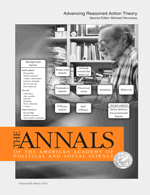Abstract:
This article serves as a guide for conducting statistical analyses in a reasoned action context. Using structural equation modeling concepts, the authors identify two elements of reasoned action data: the structural component relating theoretical variables to one another and a measurement component defining the theoretical constructs. The authors then describe a three-step analytic approach: analyzing the proximal determinants of intention to perform a behavior, analyzing the underlying beliefs, and performing a segmentation analysis for intervention design purposes. In each step, when appropriate, the authors discuss the role of background/precursor variables. The authors conclude by addressing several common analytic issues that may arise when conducting a reasoned action analysis, such as the role of past behavior and testing for moderation.
Authors
- Amy Bleakley
- Michael Hennessy



